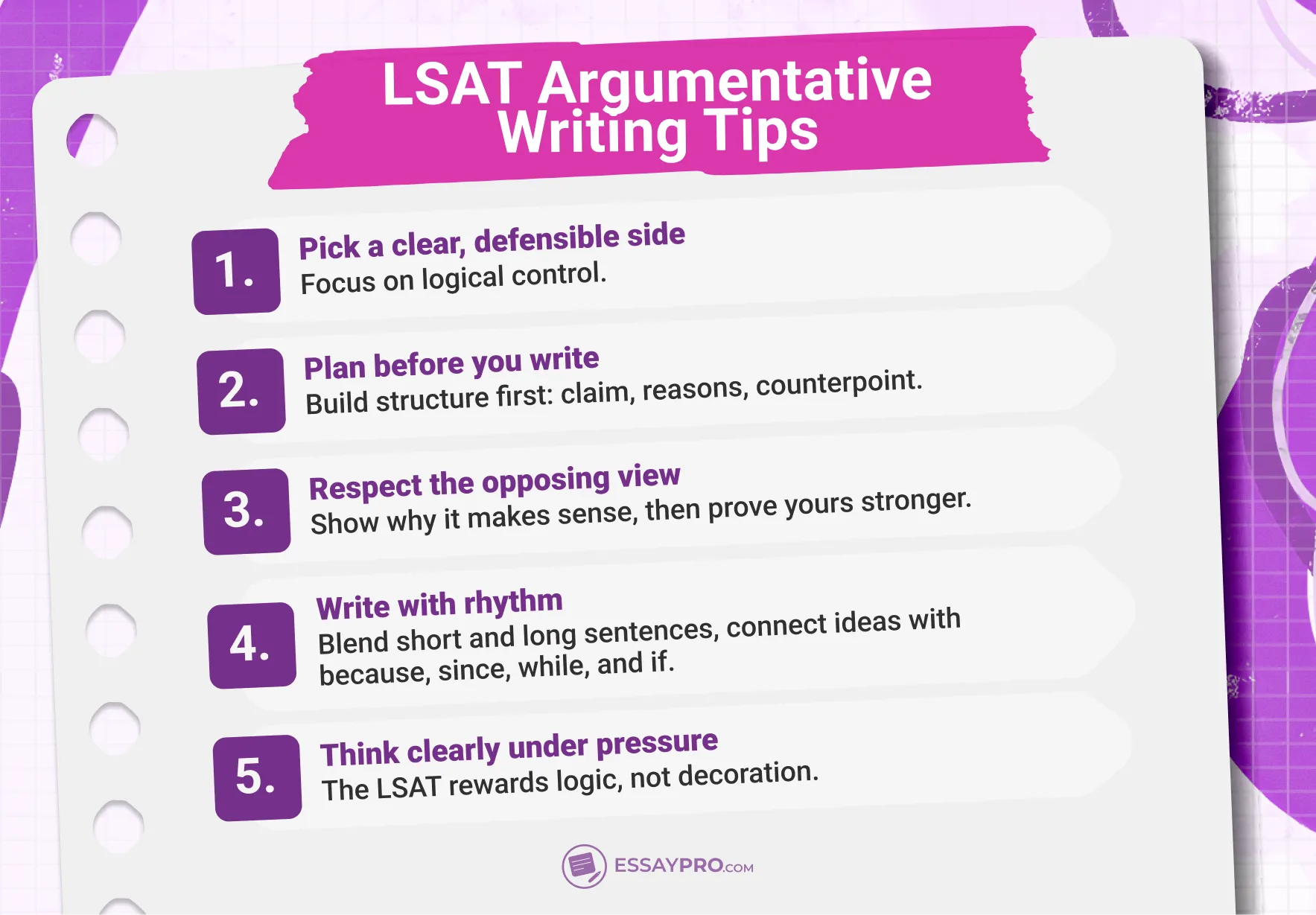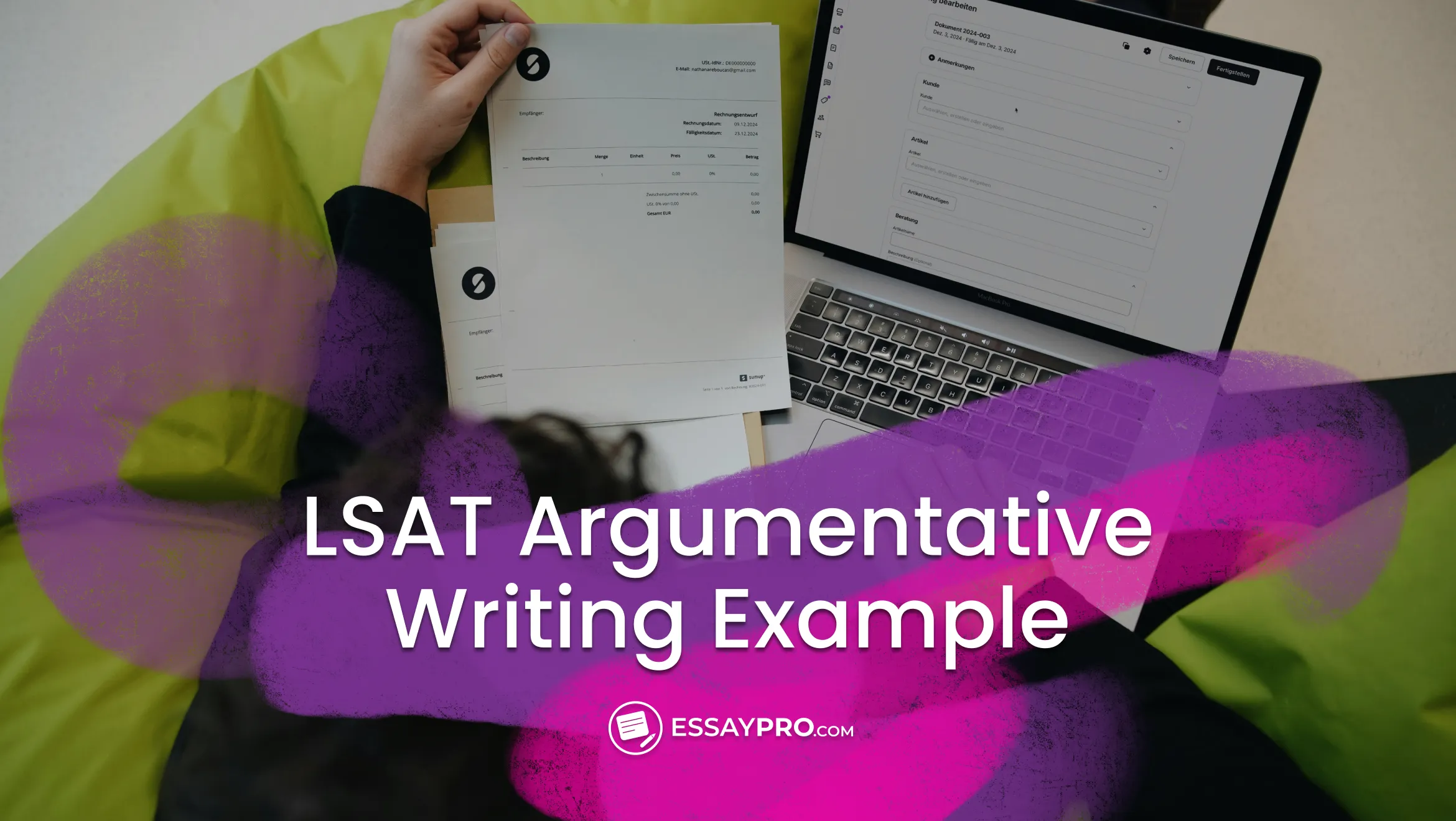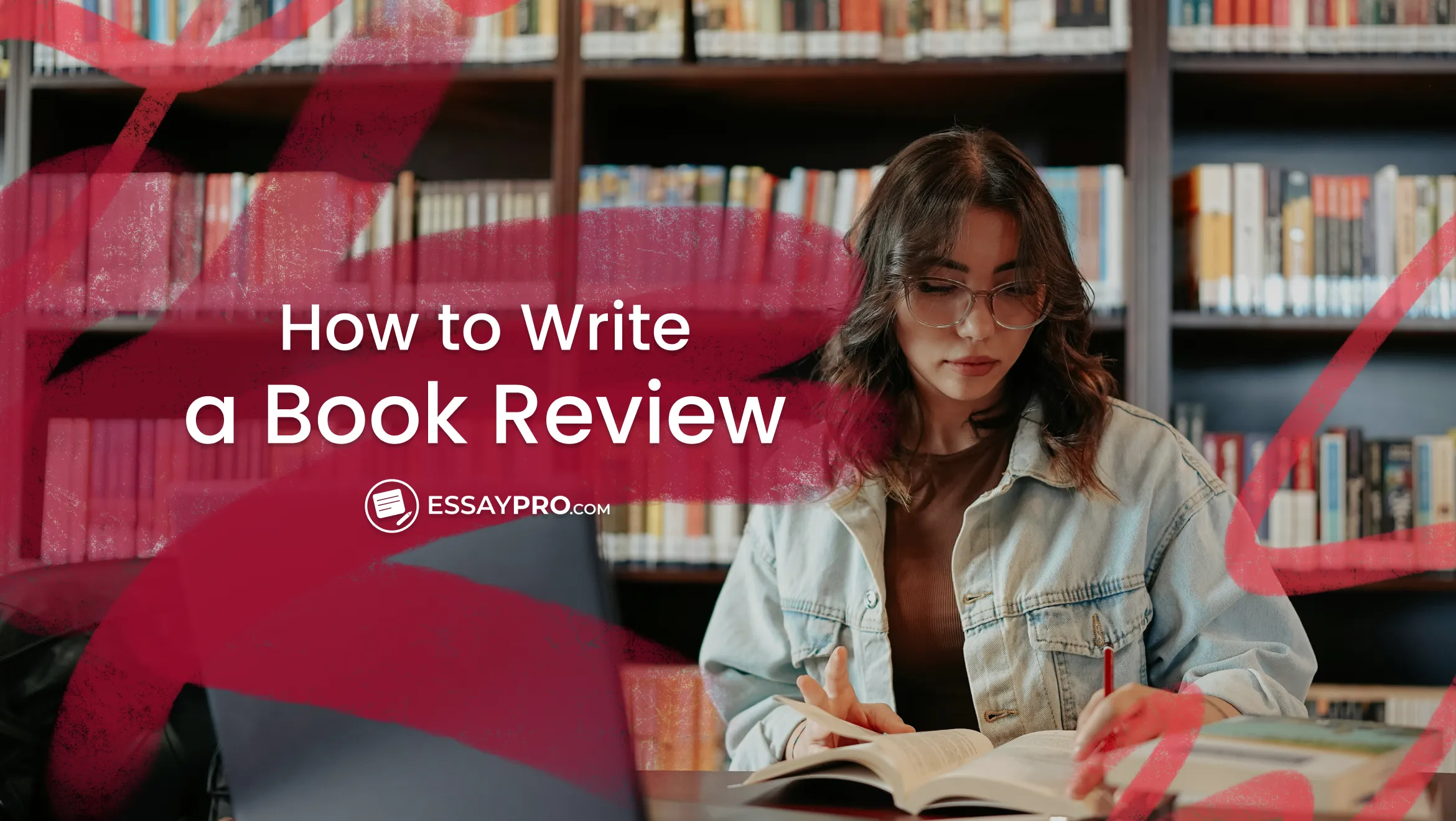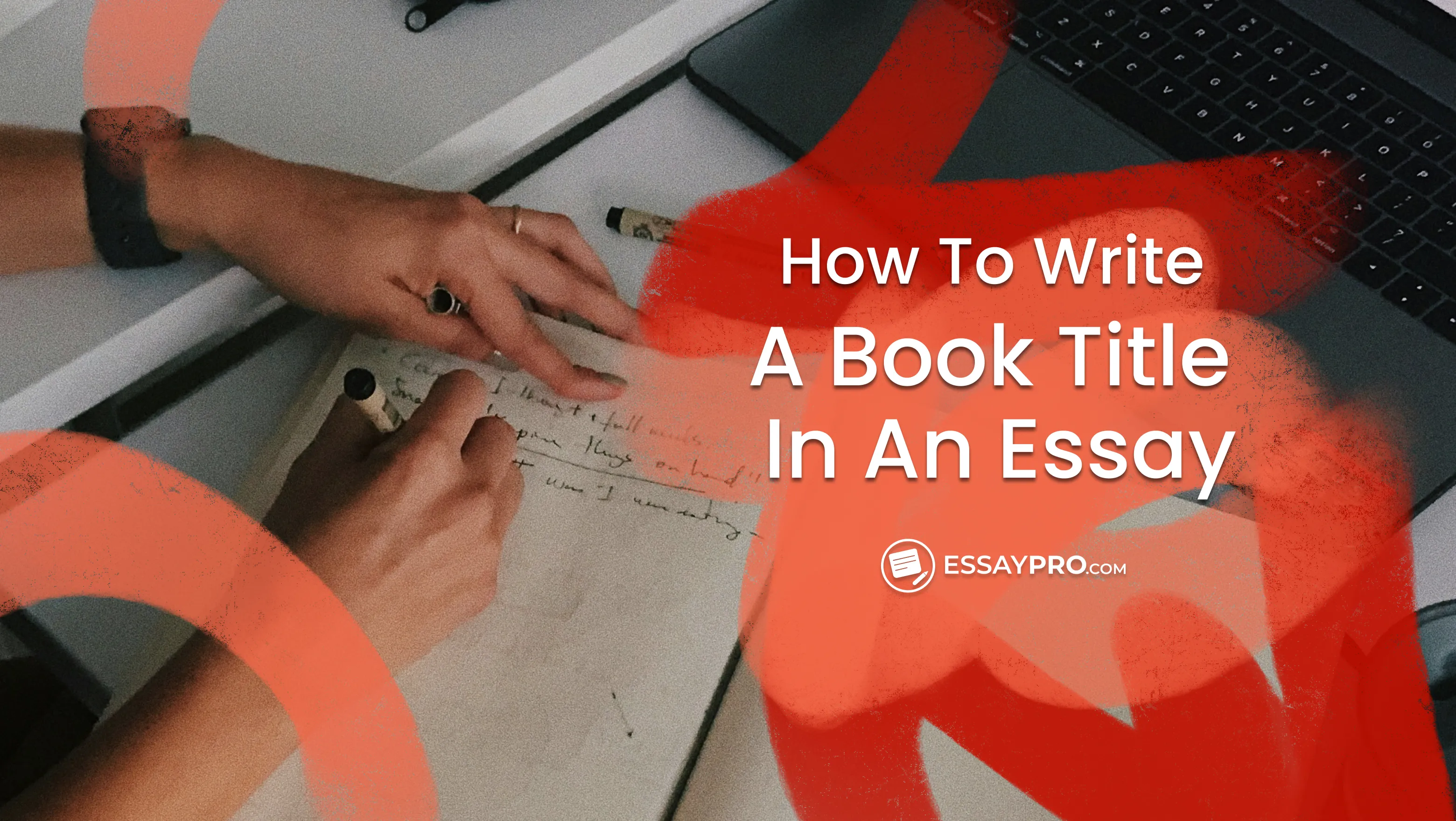LSAT stands for Law School Admission Test. It’s a diagnostic tool that evaluates a test taker’s ability to reason, analyze arguments, and write persuasively. Most test takers mistake it for a writing sample, but law schools read it not to judge prose style but to see how quickly you build hierarchy in thought, how you separate evidence from noise, prioritize principles, and keep coherence alive under time limits.
EssayPro helps you sharpen that kind of reasoning with an LSAT argumentative writing sample provided in this article. Through our assistance, you can transform scattered arguments into organized logic, precisely what the LSAT rewards.


What Is LSAT Argumentative Writing?
The LSAT argumentative writing section is the essay section of the Law School Admission Test that measures how effectively test takers construct, support, and defend a position. Each prompt presents two competing viewpoints on a realistic decision-making scenario, requiring a clear thesis and logical justification. The writing sample doesn’t affect the LSAT score but is reviewed by admissions committees to evaluate organization, reasoning, and clarity. Strong LSAT argumentative writing prep is key for applicants targeting T14 law schools.
LSAT Argumentative Essay Structure
The LSAT argumentative writing practice follows a structure that mirrors how lawyers think: present the position first, then provide the reasoning, and finally weave the evidence throughout both.
- Introduction
The opening should define the decision and name both options in the prompt. The thesis must declare your position clearly, revealing the central principle guiding your reasoning. For example, if the task asks you to choose between career readiness and liberal arts education, the thesis should reveal which better serves society and why.
- Argument Development (Body Paragraphs)
Each body paragraph should follow a single thread of reasoning. Begin with a claim that supports your thesis, then justify it with logical connections, practical examples, or consequences. Explain how certain assumptions, values, or priorities shape your perspective.
- Counterargument
The next section acknowledges the merit of the opposing option. Here, the goal isn’t to attack but to weigh. A thoughtful writer concedes valid points, then explains why their choice still stands stronger under closer scrutiny.
- Conclusion
The closing paragraph should tie the logic back to the purpose. Summarize how your evidence collectively supports the chosen stance, emphasizing consistency and sound judgment. Avoid emotional appeals. The best endings prove that your argument could stand up in a courtroom, not just a classroom.
LSAT Argumentative Writing Examples
Below you’ll find three LSAT argumentative writing prompts and sample responses, each completed writing sample based on a different kind of modern issue. The prewriting analysis and outlining your reasoning often decide whether your completed writing sample feels coherent or rushed.
Task #1
Purpose of Technology in Education
Technology shapes nearly every part of modern learning. From online courses to AI tutoring, it promises flexibility and access. Many schools believe these tools help students prepare for today’s fast-moving, career-driven world. Others worry that too much screen time weakens deeper skills like creativity, focus, and empathy. As classrooms go digital, it’s worth asking what education is meant to develop most.
Key Question
Should schools focus on technology to build career skills, or should they emphasize human-centered learning that strengthens thinking and connection?
Perspective 1: from a tech company report
Digital learning levels the playing field. Online tools give every student access to quality instruction and global ideas. In a data-driven society, digital fluency is no longer optional; it’s a survival skill. Schools that ignore this shift risk leaving graduates behind in the job market.
Perspective 2: from a classroom teacher’s journal
Technology speeds things up, but it also flattens meaning. Students scroll through tasks without grasping ideas. Real learning happens through dialogue and curiosity, not just through screens. If education’s goal is to grow citizens, not technicians, the teacher-student relationship must stay central.
Perspective 3: from a sociology paper on digital culture
Education now reflects the values of productivity and measurement. By centering efficiency, schools produce students who perform but rarely question why. To prepare people for civic life, learning must include reflection and context, not only skill acquisition.
Sample Response
Modern education stands at a crossroads between human-centered learning and technological immersion. Schools should prioritize human-centered education that develops reasoning, empathy, and adaptability while using technology as a supporting tool, not the core. What matters most is how students learn to think, not how many digital tools they can navigate.
The argument for career-focused, technology-driven learning carries weight. Today’s students will enter workplaces shaped by automation, data systems, and remote collaboration. They must be fluent in those tools. Yet, reducing education to technical training misses its broader purpose. Technology changes every few years, but the ability to question, interpret, and reason remains a lifelong skill. A student who can think deeply can learn any system later. One who relies only on system design may struggle when the system shifts.
Perspective 2 from the teacher’s journal captures this difference well. The sense of learning as conversation, where students build ideas through dialogue, cannot exist in isolation behind a screen. Critical thought develops in friction, not convenience. In digital spaces designed for speed and clarity, nuance tends to disappear. Students complete tasks efficiently but rarely pause to ask why their conclusions matter.
The deeper issue is what kind of citizens schools aim to produce. A purely career-preparatory system risks shaping workers who respond to algorithms instead of questioning them. A human-centered education, in contrast, fosters awareness of context, ethics, and shared responsibility. That is the kind of readiness most law schools and employers ultimately value: the readiness to reason under uncertainty.
Education succeeds when it equips students to learn beyond what the current decade demands. Technology can help, but humanity must lead. The classroom’s future should reflect balance, one that keeps curiosity alive while preparing students for a world still run, at its core, by human judgment.
Task #2
Purpose of Higher Education
The cost of college keeps rising, and so does the pressure to make it 'worth it.' Some people see universities mainly as career training centers, places to learn the skills that lead to steady work and financial security. Others think colleges should do more than prepare students for jobs. They see it as a place to grow as a thinker, citizen, and person. As debates about tuition, student debt, and job markets continue, the question of what higher education is really for feels more urgent than ever.
Key Question
Should universities focus on preparing students for specific careers, or should they emphasize broader learning that builds curiosity and civic understanding?
Perspective 1: from a workforce policy report
Colleges have a responsibility to meet economic demand. Employers need skilled workers, and graduates need real job prospects. When public money supports higher education, the return should be measurable in employment outcomes. Practical, career-focused programs are the fairest way to make that happen.
Perspective 2: from a literature professor’s essay
Universities exist to create understanding, not just income. When higher education centers on employability, it loses its soul. Students should leave college knowing how to think critically, engage ethically, and contribute thoughtfully to civic life. That’s what makes a society stable in the long run.
Perspective 3: from a student advocacy group statement
The problem isn't the purpose. It’s pressure. Students feel trapped between following their interests and choosing degrees that promise security. Rising tuition makes college a financial risk, not a place of discovery. Education should help people find a balance between passion and practicality.
Sample Response
Universities should emphasize broader learning that develops intellectual and civic understanding while still preparing students for practical work. Career training matters, but education built only on employability shrinks the idea of what a university is meant to do. The point of higher education is to shape minds that can adapt, not simply fit into the next available job.
The argument for career-focused education, as Perspective 1 notes, has real force. Students and taxpayers want measurable results. It seems fair to expect a clear link between a degree and a paycheck. Yet this view assumes that job markets remain stable and predictable. They rarely do. Industries evolve, technologies shift, and skills that seem essential today often lose relevance within a few years. A graduate who only learned what to do, not how to think, ends up less prepared for those changes.
Broader learning creates a different kind of readiness. When students study history, philosophy, or literature, they don’t memorize facts for their own sake. They practice reasoning, empathy, and judgment; the same traits that lawyers, policymakers, and engineers rely on when facing new problems. As Perspective 2 reminds us, these capacities protect democracy itself. A society of specialists without reflection risks becoming efficient but shallow, able to build systems it no longer understands.
Perspective 3 adds another important point: pressure. The cost of college has turned education into a financial gamble, which leads students to chase whatever path appears safest. That economic anxiety distorts learning. A university that values curiosity as much as career readiness gives students permission to take intellectual risks, to follow questions, not just salaries. Those risks often lead to unexpected innovation.
The deeper issue isn’t which path is more useful; it’s what kind of society universities are building. Career-focused education serves the economy. Broader education serves the mind that shapes the economy. When universities maintain that distinction, they graduate individuals capable of both doing and thinking, a combination that no job market can replace.
Task #3
Social Media and Free Expression
Online platforms have become the main arena for public debate. Many people see them as spaces where anyone can share ideas and challenge authority. Others argue that these same platforms spread misinformation, polarize communities, and silence meaningful discussion. As governments and companies decide how to regulate online speech, the question of what constitutes 'free expression' becomes increasingly complex.
Key Question
Should social media platforms limit harmful content to protect public discourse, or should they allow unrestricted expression to preserve free speech?
Perspective 1: from a digital rights organization
Free expression loses its meaning once private companies decide what people can say. The internet remains the closest thing humanity has built to a public square. Restricting speech, even to prevent harm, gives too much power to corporations and too little to citizens.
Perspective 2: from a media literacy researcher
Unrestricted expression doesn’t guarantee a healthier democracy. Misinformation spreads faster than truth online, and algorithms reward outrage. Protecting open debate sometimes means setting boundaries that prevent manipulation. Without limits, the loudest voices drown out the rest.
Perspective 3: from a journalist’s editorial
The debate over 'free speech' online hides a deeper problem: attention. When every opinion competes for clicks, truth becomes secondary to visibility. What matters isn’t who can speak, but who gets heard. Regulation should focus less on censorship and more on transparency about how visibility is shaped.
Sample Response
Social media platforms should limit the dissemination of harmful content to protect public discourse. Free expression matters, but expression without context or responsibility can turn chaotic quickly. The health of a democracy depends less on how loudly people can speak and more on whether truth still has a place to be heard.
Perspective 1 argues that once companies decide what constitutes acceptable speech, freedom itself becomes weakened. That concern makes sense. A handful of corporations now control most of the world’s digital communication. Their decisions can shape elections, influence markets, and define reputations. But pretending that 'no rules' equals 'free speech' ignores how online spaces already operate. Algorithms act as invisible editors. They decide which voices get amplified and which disappear. That’s a kind of control too, just hidden behind code instead of policy.
Perspective 2 recognizes this imbalance. The online environment rewards speed, anger, and repetition, meaning, traits that make misinformation spread faster than corrections ever could. When every claim, no matter how false, competes for the same attention, truth loses traction. Setting clear limits on targeted misinformation or incitement doesn’t silence debate; it creates room for genuine argument to survive. Freedom of speech without structures of accountability leaves the public more misled than empowered.
Perspective 3 touches the core problem: attention, not access. The internet turned expression into performance, and platforms profit from outrage. In that economy, harmful content thrives because it keeps users engaged by encouraging them to scroll. Regulation, then, isn’t about silencing voices but slowing the machinery that turns conflict into currency. Making algorithms transparent and curbing viral falsehoods strengthens the very freedom those systems now erode.
Free speech has never meant speech without consequence. Every society draws lines somewhere, such as libel laws, incitement limits, and classified information. The digital era simply makes the stakes visible in real time. When lies and hate scale faster than reason, restraint becomes a form of protection, not censorship.
If social media is the new public square, then its freedom depends on the quality of the conversations it hosts. Protecting that conversation means designing boundaries that serve truth, not noise.
For more inspiration beyond the LSAT format, you can also see a wide range of good argumentative essay topics that develop similar reasoning skills.
LSAT Argumentative Writing Tips
The LSAT writing task doesn’t reward clever language or memorized templates. The test asks a simple question: Can you think clearly when the clock is loud? These tips for LSAT argumentative writing will help you sound more deliberate and less mechanical.

- Take a position that feels defensible, not perfect: Many test takers waste precious minutes hunting for the “right” answer. There isn’t one. What matters is whether you can turn uncertainty into order. Pick a side that gives you room to reason.
- Start with structure before sentences: Each LSAT argumentative writing starting point is structure. Lead with a clear claim, stack two or three reasons beneath it, then leave space for a counterpoint.
- Treat the counterargument as a test, not an enemy: Acknowledge what makes the other side tempting, and then dismantle it piece by piece. This shows you can hold two truths in your mind at once and still decide which one carries more weight.
- Write with legal rhythm: Short sentences show control, while longer ones reveal depth. Mix them. Use transitions that show reasoning: because, since, while, if.
If you want expert insight into your drafts, explore EssayPro’s custom law essay writing service.
Final Words
Each LSAT argumentative writing task reveals how you handle conflict between two reasonable ideas and rank priorities. If you can do that right, that means you have learned how to think under pressure, and that’s something that every lawyer needs to demonstrate long before they ever step into a courtroom.
If you need more help with your homework, EssayPro has got you covered. You can team up with our law assignment writer and get personalized support, whether for an LSAT sample or a full research paper.
FAQs
What Is LSAT Argumentative Writing?
It’s the essay portion of the Law School Admission Test where you take a side on a given issue and defend it with logic and evidence. Law schools use it to see how clearly you organize ideas and reason through complex choices.
How Long Is LSAT Argumentative Writing?
You get 35 minutes to plan, write, and proofread your response. That short time frame tests how efficiently you can think and write.
Is the LSAT Argumentative Writing Graded?
No, it isn’t scored, but law schools receive your writing sample. Admissions readers look at it for reasoning, coherence, and professionalism rather than grammar or style.
How to Prepare for LSAT Argumentative Writing?
Practice with real prompts, time yourself, and review each essay for structure. Focus on clear logic, steady tone, and organized support. Reading LSAT argumentative writing examples can also show what strong reasoning looks like under pressure.
Does LSAT Argumentative Writing Matter?
Yes. While unscored, it still shapes first impressions. It provides admissions committees with a direct view of your analytical process, how you construct arguments, weigh evidence, and communicate judgment, all practical career skills for success in law school.

Mariam Navrozashvili
She has a Master’s degree in English Literature and brings a deep understanding of storytelling, critical analysis, and language structure to her work. On EssayPro Blog Mariam writes guides on literary analysis, essay composition and language studies to help students improve their writing skills. In her free time she likes to read classic novels and discuss literary theory.
- Law School Admission Council. (n.d.). Frequently asked questions about LSAT argumentative writing. LSAC. https://www.lsac.org/lsat/frequently-asked-questions-about-lsat/frequently-asked-questions-about-lsat-argumentative
- Manhattan Review. (n.d.). LSAT writing sample topics. https://www.manhattanreview.com/lsat-writing-sample-topics/
- U.S. News & World Report. (2023, February 27). What to know about the LSAT writing sample. Retrieved October 22, 2025, from https://www.usnews.com/education/blogs/law-admissions-lowdown/articles/what-to-know-about-the-lsat-writing-sample








